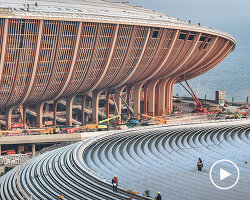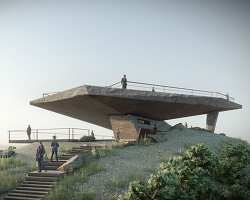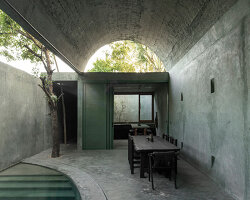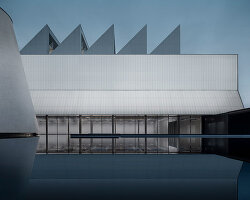the new landmark museum for chengdu
Nestled amidst the bustling cityscape of Chengdu, Pelli Clarke & Partners‘ newly completed Chengdu Museum of Natural History resembles a natural monolith. The larger than life museum covers 540,000 square feet (50,000 square meters), and serves as a beacon of culture and scientific exploration in the Chinese city. With its grand exhibits, public spaces, shops, café, cinema, and state-of-the-art educational facilities, this museum has become a cultural landmark for the city, reflecting its rapid rise as a hub for technology.
 image courtesy Pelli Clarke & Partners | header image © Xiaobin Lv
image courtesy Pelli Clarke & Partners | header image © Xiaobin Lv
A Living Tribute to Chengdu’s Heritage
The design of the Chengdu Museum of Natural History is an homage to the rich heritage and vibrant spirit of Chengdu. Drawing inspiration from the local elements of ‘Shu Mountain, Shu Road, Shu Water,’ the architects have masterfully synthesized the historical culture and context of the city. The building’s massing is reminiscent of the majestic Sichuan mountain forms, shaped by the shifting tectonic plates that have defined the region for centuries. These volumes gracefully mirror the natural process of rock breaking apart and shifting under the forces of nature.
 image courtesy Pelli Clarke & Partners
image courtesy Pelli Clarke & Partners
Form as an Artistic Expression
The architectural form of the museum unveils itself as an artistic expression of the landscape surrounding Chengdu. The building emerges from the ground, revealing captivating public spaces within, while firmly rooted to the earth. Each individual mountain, or rock volume, serves as a distinct exhibit space, united by light-filled public areas that foster connection and interaction. The selection of materials further reflects the narrative of tectonic plates, with the exterior facade clad in locally sourced granite. The organically shaped and carefully composed perforations in the stone create an ethereal impression of snow-covered mountains during the day, while LED backlighting brings forth a luminous, starlit spectacle at night.

image © Arch-Exist Photography
discovering natural history
The design of the museum embraces the allure of Chengdu’s iconic mountain paths, known as ‘蜀道’ (Shu Dao). Embodying the spirit of adventure, a glass-enclosed circulation space gracefully winds along the museum’s eastern facade, connecting the second and third levels. This suspended pathway offers visitors an interactive journey, meandering amidst life-size dinosaur exhibits that appear suspended from the ceiling. The transparent and glassy clefts between the rock forms invite reflection, observation, and interaction, serving as visual and physical connections between the exhibits, the city, the street, the landscape, and the canal.

image © Arch-Exist Photography
the monolith among a garden landscape
The museum’s landscape design draws inspiration from traditional regional irrigation systems, resulting in a tapestry of reflecting pools and tributaries that frame the building. Water features breathe life into the surroundings, activating the building and enhancing the human experience. Embracing native flora, the landscape design provides habitats for wildlife and pollinator corridors. The existing Dongfeng Canal on the site’s eastern edge finds its mirror image in a network of waterways and reflecting pools. Varied and indigenous plants create terraced gradients, reminiscent of the historical agricultural landscape, with captivating gardens such as the Wetland Garden, Bamboo Garden, Water Lily Garden, and Seasonal Plant Garden.
 image © Xiaobin Lv
image © Xiaobin Lv
environmental stewardship by pelli clarke & partners
At the heart of the museum’s design is a commitment to environmental stewardship. The green building strategy encompasses various measures to minimize the museum’s ecological impact, improve energy efficiency, and support the natural environment. From material selection and intelligent sourcing to energy-efficient technologies and waste management, every aspect has been carefully considered. The use of steel over concrete reduces the carbon footprint, while locally sourced granite minimizes transportation requirements.
Energy-efficient systems, including intelligent LED lighting control and high-performance glass and insulation, reduce energy consumption and carbon emissions. A rainwater harvesting system collects and reuses water for non-potable demands, while abundant natural lighting reduces the need for artificial lighting. Waste management practices prioritize recycling, sorting, and reuse, further minimizing environmental impact.

image courtesy Pelli Clarke & Partners
building the complex structure
The Chengdu Museum of Natural History showcases the seamless integration of advanced technology and architectural design. The implementation of a folded, double-layer rainscreen wall, featuring over 70 folded surfaces and more than 6,000 outer curtain wall supports, evokes the craggy texture of mountains. Illuminated by an LED backlighting system, the perforations in the granite create a mesmerizing nighttime spectacle reminiscent of a starry sky. Advanced software played a vital role in designing and implementing the complex steel structure, ensuring precise positioning and efficient construction. Environmental protection machinery, noise reduction measures, and adherence to strict rules and regulations further demonstrate the architects’ commitment to a sustainable and responsible construction process.

image courtesy Pelli Clarke & Partners

image courtesy Pelli Clarke & Partners











project info:
project title: Chengdu Museum of Natural History
architecture: Pelli Clarke & Partners | @pcparch
location: Chengdu, China
design team: Kristin Hawkins, Cory Frost, Hongxi Yang, Rong Chen, Ileana Dumitriu, Olivia Huang, Jie Zhang, Chen Chen, Beidi Zheng
architect of record, structural engineer, MEP: China Southwest Architectural Design and Research (CSWADI)
landscape architect: Land Artitude Corporation
completion: 2022
photography: © Arch-Exist Photography, @archexist, Xiaobin Lv, Pelli Clarke & Partners























